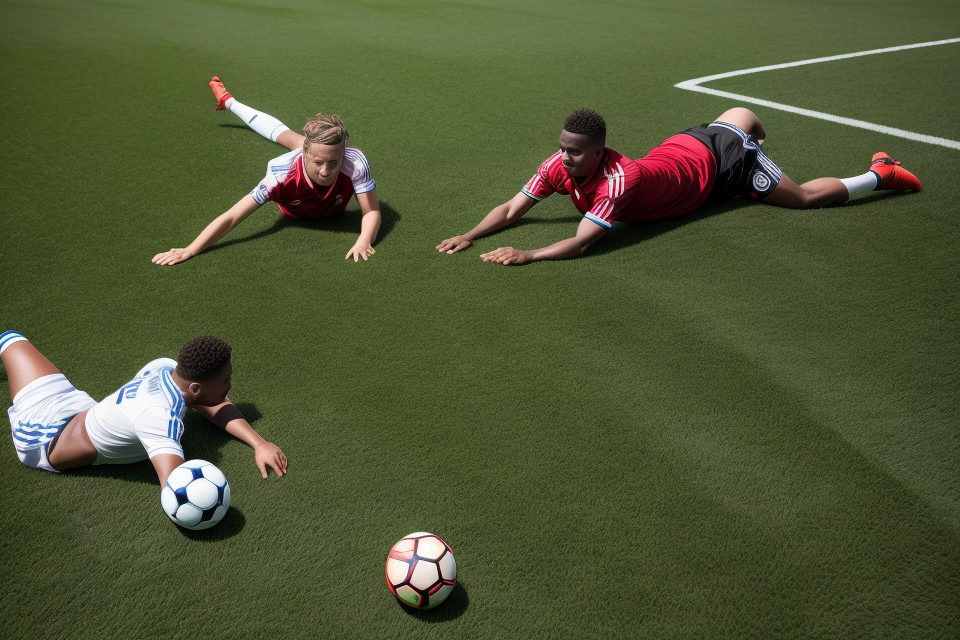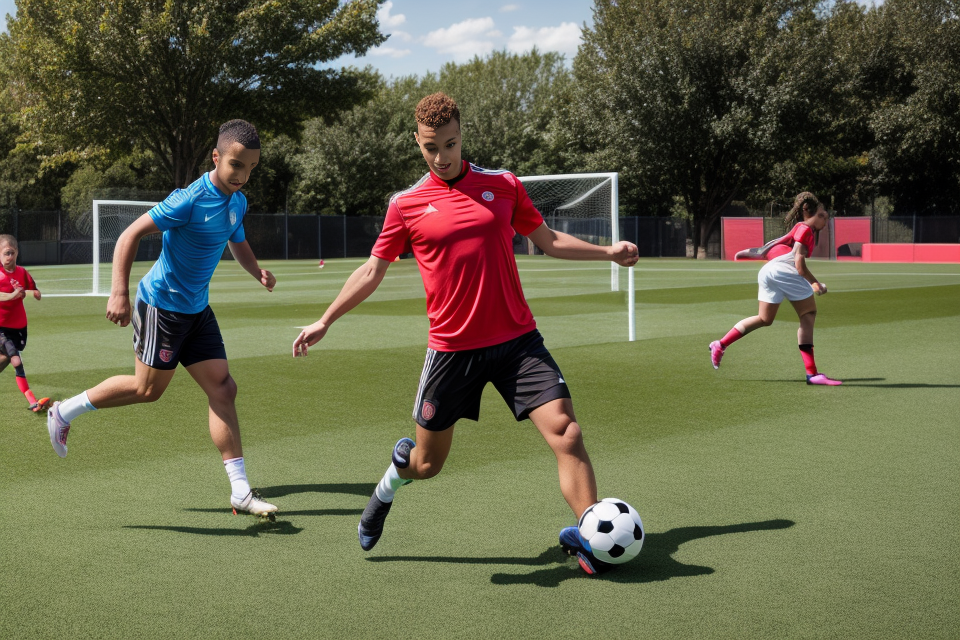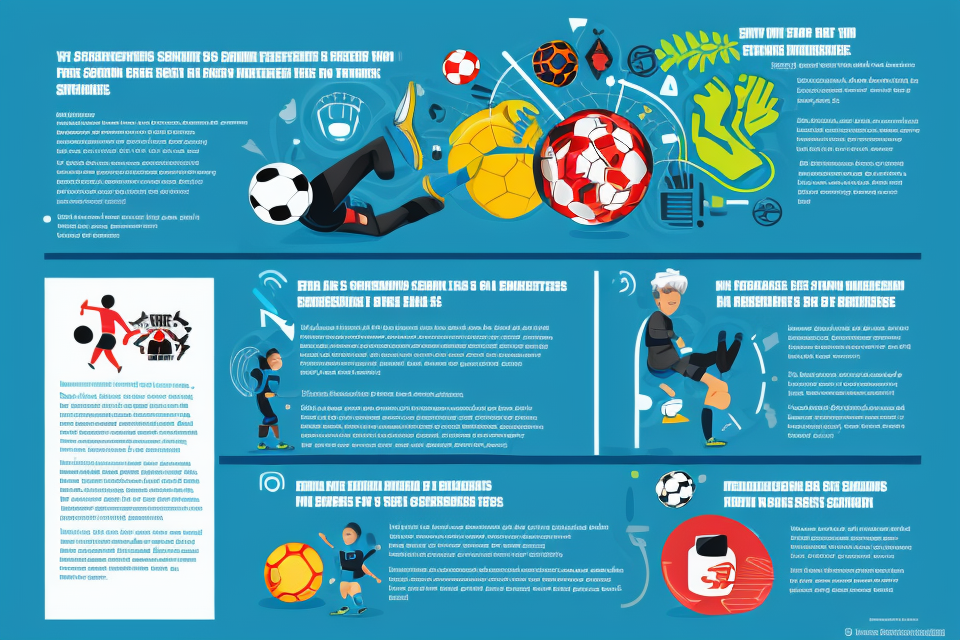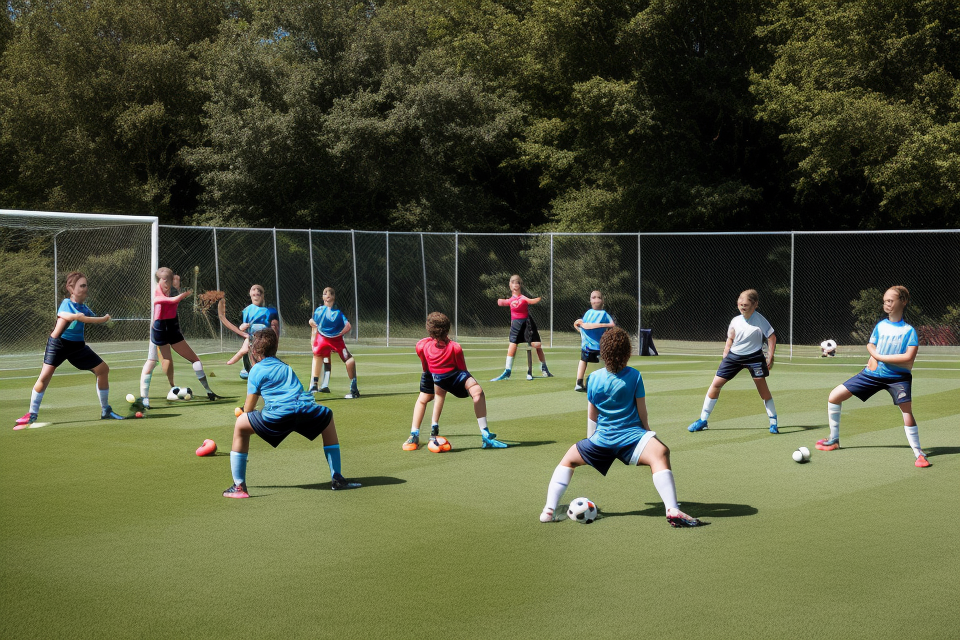Soccer is one of the most popular sports in the world, with millions of players participating at all levels of competition. While the sport is known for its excitement and passion, it is also known for its high injury rate. From minor sprains and strains to serious concussions and fractures, soccer injuries can have a significant impact on a player’s career and overall health. In this comprehensive guide, we will explore the prevalence and prevention of soccer injuries, looking at the latest research and techniques for reducing the risk of injury on the field. Whether you’re a player, coach, or fan, this guide will provide valuable insights into the world of soccer injuries and how to stay safe on the field.
Understanding Soccer Injuries: Types, Causes, and Prevalence
Common Soccer Injuries
Muscle Strains
Muscle strains are a common injury in soccer, particularly among players who engage in high-intensity activities such as sprinting and changing direction rapidly. These injuries occur when muscle fibers are stretched beyond their normal limits, often resulting in pain, inflammation, and reduced muscle function. Common sites for muscle strains in soccer include the hamstrings, quadriceps, and calf muscles.
Ligament Sprains
Ligament sprains are another prevalent injury in soccer, often occurring due to sudden changes in direction or collisions with other players. These injuries occur when ligaments, which connect bones and provide stability to joints, are stretched or torn. Common sites for ligament sprains in soccer include the ankle, knee, and shoulder joints.
Concussions
Concussions are a type of traumatic brain injury that can occur in soccer due to head-to-head collisions or heading the ball. These injuries result from the brain moving rapidly back and forth within the skull, causing damage to nerve cells and potentially leading to long-term cognitive impairments. Symptoms of a concussion may include headache, dizziness, confusion, and memory loss.
Ankle Injuries
Ankle injuries are common in soccer, particularly among players who make rapid changes in direction or engage in high-impact activities such as jumping and landing. Common ankle injuries in soccer include sprains, strains, and fractures. Ankle sprains occur when ligaments are stretched or torn, while ankle strains involve muscle or tendon damage. Fractures may occur due to direct impact or repetitive stress on the ankle joint.
Knee Injuries
Knee injuries are also prevalent in soccer, particularly among players who engage in high-impact activities or experience sudden changes in direction. Common knee injuries in soccer include anterior cruciate ligament (ACL) sprains, medial collateral ligament (MCL) sprains, and meniscal tears. ACL sprains occur when the ligament connecting the thigh and shin bones is stretched or torn, while MCL sprains involve damage to the ligament on the inner knee. Meniscal tears refer to damage to the cartilage in the knee joint.
Factors Contributing to Soccer Injuries
Poor training techniques
Injuries can occur when athletes engage in high-intensity or high-impact training sessions without proper guidance or supervision. Insufficient recovery time between workouts, excessive training loads, and the failure to incorporate rest and regeneration periods into training regimens can all contribute to increased risk of injury. Additionally, improperly executed drills or exercises can lead to muscle imbalances, weaknesses, and other underlying issues that may predispose players to injury.
Lack of proper equipment
Proper protective gear, such as shin guards, cleats, and headgear, can help reduce the risk of injury. However, many players, particularly at the amateur level, may not have access to appropriate equipment or may not use it correctly, increasing their susceptibility to injury. In addition, poorly maintained or damaged equipment can also contribute to injuries, such as falls or collisions with other players.
Insufficient warm-up and cool-down exercises
Insufficient warm-up and cool-down exercises can increase the risk of injury by placing undue stress on muscles, tendons, and ligaments. A proper warm-up should include dynamic stretching, light aerobic activity, and mobility exercises to prepare the body for physical activity. Conversely, a proper cool-down should include static stretching and other relaxation techniques to help the body recover and reduce the risk of stiffness or soreness.
Inadequate field conditions
Inadequate field conditions, such as poorly maintained or uneven playing surfaces, can contribute to injuries by increasing the risk of slips, trips, and falls. Additionally, playing on fields with inadequate lighting or poorly marked boundaries can increase the risk of collisions or other accidents.
Genetic predisposition
Some players may be genetically predisposed to certain injuries due to factors such as muscle imbalances, weaknesses, or laxity in joints. For example, players with a higher risk of ACL injuries may have certain anatomical features that make them more susceptible to these types of injuries. However, it is important to note that genetic predisposition alone does not guarantee injury, and other factors such as training, equipment, and environmental factors can still play a significant role in injury prevention.
Prevalence of Soccer Injuries
Rates of soccer injuries vary based on factors such as age, gender, and skill level. Studies have shown that high school soccer players are at the highest risk of sustaining injuries, with the most common injuries occurring to the ankle, knee, and thigh. Professional soccer players also experience a high injury rate, with the most common injuries occurring to the same areas of the body as well as the head and neck. Additionally, research has shown that male soccer players tend to experience more injuries than female players, and that more experienced players may be at a higher risk for overuse injuries.
The Science Behind Soccer Injuries Prevention
Understanding Injury Mechanisms
In order to prevent soccer injuries, it is important to understand the mechanisms by which they occur. There are several factors that contribute to soccer injuries, including the type of injury, the playing surface, the player’s physical condition, and the equipment used.
How injuries occur in soccer
In soccer, injuries can occur in a variety of ways. One common mechanism of injury is collision, which can happen when two players collide while competing for the ball. Another common mechanism of injury is overuse, which can occur due to repetitive movements or a lack of rest. Finally, sudden changes in direction or acceleration can also lead to injuries, such as twists or sprains.
Importance of injury prevention strategies
Preventing soccer injuries is crucial for maintaining player health and ensuring successful team performance. Injury prevention strategies can include proper warm-up and cool-down techniques, stretching and strengthening exercises, and injury-specific training programs. Additionally, wearing appropriate equipment, such as shin guards and mouthguards, can help reduce the risk of injury. By understanding the mechanisms of soccer injuries, coaches and players can work together to implement effective injury prevention strategies and promote a safe and enjoyable playing experience.
Evidence-Based Prevention Techniques
Proper warm-up and cool-down exercises
Injury prevention begins with a comprehensive warm-up and cool-down regimen. Warm-up exercises should focus on increasing blood flow to the muscles, loosening tight muscles, and activating the muscles needed for soccer performance. Warm-up exercises can include dynamic stretching, such as leg swings and hip circles, as well as mobility exercises to improve range of motion in the ankles, hips, and thoracic spine. A proper cool-down should include static stretching to help muscles recover and prevent soreness.
Strength and conditioning programs
A strength and conditioning program can help prevent soccer injuries by improving overall fitness, muscular strength, and muscular endurance. This can include resistance training exercises such as squats, lunges, deadlifts, and single-leg deadlifts, as well as plyometric exercises to improve power and explosiveness. It is important to incorporate exercises that target the muscles used in soccer, such as the quadriceps, hamstrings, glutes, and calves.
Injury-specific prevention drills
In addition to general strength and conditioning, injury-specific prevention drills can help reduce the risk of common soccer injuries. For example, drills to prevent anterior cruciate ligament (ACL) injuries may include bounding and cutting exercises, while drills to prevent hamstring strains may include eccentric strength training. It is important to incorporate these injury-specific drills into training to help reduce the risk of injury.
Incorporating plyometrics and agility training
Plyometrics and agility training can help improve power, speed, and change of direction ability, which are important factors in soccer performance and injury prevention. Plyometric exercises, such as box jumps and depth jumps, can help improve explosiveness and power, while agility drills, such as ladder drills and shuffle drills, can help improve change of direction ability. These exercises should be incorporated into training to help prevent soccer injuries.
Ensuring proper equipment and field conditions
Proper equipment and field conditions are also important in preventing soccer injuries. Players should wear appropriate shoes that provide adequate support and protection, and use shin guards to prevent shin splints and other lower leg injuries. Field conditions should also be monitored to ensure that the playing surface is safe and free of hazards, such as debris or potholes. Proper equipment and field conditions can help reduce the risk of soccer injuries.
The Role of Technology in Injury Prevention
Advances in sports medicine and technology have revolutionized the way soccer injuries are prevented. Here are some of the ways technology is being used to reduce the risk of injury in soccer players:
Use of GPS tracking and motion analysis to monitor player movements
GPS tracking and motion analysis are two technologies that are widely used in soccer to monitor player movements. GPS tracking involves attaching a GPS device to a player’s jersey, which allows coaches and trainers to track the player’s movements during a match or training session. This data can be used to identify patterns in the player’s movements, such as the distance covered, average speed, and number of sprints.
Motion analysis, on the other hand, involves using cameras or sensors to track the player’s movements and provide detailed information on their technique, biomechanics, and movement patterns. This information can be used to identify areas where the player needs to improve their technique, such as their running or jumping form, and to prevent injuries that may be caused by poor technique.
Injury prediction models and risk assessment tools
Injury prediction models and risk assessment tools are two other technologies that are being used to prevent soccer injuries. Injury prediction models use data from past injuries, player characteristics, and playing conditions to predict the likelihood of future injuries. This information can be used to identify players who are at a higher risk of injury and to take preventative measures, such as reducing their training load or providing them with extra recovery time.
Risk assessment tools, on the other hand, are used to assess the risk of injury in different situations on the pitch. For example, a risk assessment tool may be used to determine the risk of injury when a player is tackled, headed the ball, or engaged in high-intensity activities. This information can be used to develop targeted interventions to reduce the risk of injury in these situations.
Overall, technology is playing an increasingly important role in injury prevention in soccer. By using GPS tracking, motion analysis, injury prediction models, and risk assessment tools, coaches and trainers can identify patterns and risk factors for injury, and take targeted measures to reduce the risk of injury in soccer players.
Implementing Injury Prevention Strategies for Soccer Players
Pre-Season Preparation
Pre-season preparation is a crucial aspect of injury prevention for soccer players. It involves developing a comprehensive training program that includes injury prevention exercises and a gradual progression of training intensity. The following are some of the key elements of pre-season preparation for soccer players:
- Developing a Comprehensive Training Program: A well-designed training program should include a combination of strength and conditioning exercises, technical drills, and tactical exercises. The program should be tailored to the individual needs of each player, taking into account their position on the field, their playing style, and their fitness level.
- Incorporating Injury Prevention Exercises: Injury prevention exercises are designed to strengthen areas of the body that are prone to injury in soccer, such as the lower back, hips, and thighs. Examples of injury prevention exercises include hip flexor stretches, core strengthening exercises, and plyometric drills. These exercises should be incorporated into the training program and performed regularly throughout the season.
- Gradual Progression of Training Intensity: It is important to gradually increase the intensity of training over the course of the pre-season to avoid injury. This can be achieved by gradually increasing the duration and intensity of training sessions, as well as the number of training sessions per week. It is also important to allow for adequate rest and recovery time between training sessions.
By following these pre-season preparation strategies, soccer players can significantly reduce their risk of injury and improve their overall performance on the field.
In-Season Maintenance
Monitoring Player Conditioning and Injuries
One crucial aspect of in-season maintenance is closely monitoring the physical condition of each player. This involves assessing their fitness levels, muscle imbalances, and any pre-existing injuries. By doing so, coaches and trainers can tailor their training programs to each individual’s needs, reducing the risk of further injury and ensuring optimal performance throughout the season.
Adjusting Training Regimens as Needed
In addition to monitoring player conditioning, it is essential to adjust training regimens as needed to prevent injuries. This may involve reducing the intensity or duration of certain drills, particularly in the days following a match. It could also mean incorporating more rest and recovery time into the schedule to allow players to adequately address any lingering fatigue or soreness.
Incorporating Rest and Recovery Days
Incorporating rest and recovery days into the training schedule is critical for injury prevention. This includes allowing players time off from training to allow their bodies to heal and rejuvenate. It also means scheduling recovery sessions, such as yoga or massage therapy, to help alleviate muscle soreness and reduce the risk of injury.
Overall, in-season maintenance is an essential aspect of injury prevention for soccer players. By closely monitoring player conditioning, adjusting training regimens as needed, and incorporating rest and recovery days, coaches and trainers can help minimize the risk of injury and ensure that players remain in top form throughout the season.
Post-Season Rehabilitation
- Rehabilitation techniques for common soccer injuries
- Gradual return to play protocols
- Long-term injury prevention strategies
Rehabilitation Techniques for Common Soccer Injuries
After the soccer season, players may have incurred various injuries, including muscle strains, sprains, or tears. Effective rehabilitation techniques are essential to help players recover and prevent future injuries. These techniques may include:
- Soft tissue mobilization: This technique involves manual therapy to improve soft tissue mobility and reduce scar tissue formation.
- Strength and conditioning exercises: These exercises are designed to strengthen muscles and improve flexibility, which can help prevent future injuries.
- Sport-specific drills: Sport-specific drills help players regain their ability to perform at their best, reducing the risk of reinjury.
Gradual Return to Play Protocols
After an injury, it is crucial to follow a gradual return to play protocol to prevent further injury. This protocol involves a step-by-step approach to progressively increase the intensity and duration of exercise.
- Initial phase: This phase involves light activity, such as walking or gentle stretching, to avoid pain and inflammation.
- Intermediate phase: This phase involves sport-specific drills and gradually increasing the intensity of exercise.
- Advanced phase: This phase involves full participation in training and competition.
Long-term Injury Prevention Strategies
To prevent injuries from occurring in the first place, it is essential to implement long-term injury prevention strategies. These strategies may include:
- Warm-up and cool-down exercises: Warm-up exercises help prepare the body for physical activity, while cool-down exercises help prevent soreness and reduce the risk of injury.
- Proper equipment: Wearing appropriate footwear and using protective gear, such as shin guards, can help prevent injuries.
- Strength and conditioning: Regular strength and conditioning exercises can help improve muscle strength and endurance, reducing the risk of injury.
- Hydration: Staying hydrated during physical activity can help prevent dehydration, which can lead to injuries.
By implementing these injury prevention strategies, soccer players can reduce their risk of injury and enjoy a successful and healthy soccer season.
Addressing the Myths and Misconceptions Surrounding Soccer Injuries
Common Misconceptions
Soccer is a non-contact sport, so injuries are rare
Despite its reputation as a non-contact sport, soccer is, in fact, a physically demanding and high-impact activity that can result in a wide range of injuries. The nature of the game, which involves rapid changes of direction, sudden stops, and collisions with other players, creates a significant risk of injury. While some injuries in soccer may be caused by accidents or external factors, many are the result of poor technique, lack of proper training, or inadequate preparation.
Injuries only happen to players who are not skilled or experienced enough
Another common misconception about soccer injuries is that they only happen to players who are not skilled or experienced enough. This could not be further from the truth. In fact, research has shown that the risk of injury is higher among elite players than among recreational players. This is likely due to the increased intensity and physical demands of top-level competition, as well as the greater focus on performance and success at the elite level.
Additionally, while some injuries may be more common among younger or less experienced players, this is often due to factors such as lack of proper technique, inadequate preparation, or insufficient conditioning. By following proper training protocols and techniques, as well as implementing injury prevention strategies, players of all skill levels can significantly reduce their risk of injury.
Injuries are solely caused by bad luck or external factors
Finally, it is important to dispel the myth that injuries in soccer are solely caused by bad luck or external factors. While some injuries may be the result of unavoidable accidents or circumstances beyond a player’s control, many are preventable through proper preparation, training, and injury prevention strategies.
By understanding the underlying causes of soccer injuries and taking proactive steps to prevent them, players can stay healthy and perform at their best, regardless of their skill level or experience.
Debunking the Myths
Soccer is a high-impact sport with a significant risk of injury
Soccer is often perceived as a high-impact sport that carries a substantial risk of injury. While it is true that soccer involves running, jumping, and collisions, it is important to understand that not all injuries are caused by high-impact movements. In fact, many injuries in soccer are the result of overuse, poor technique, or lack of proper preparation. Therefore, it is crucial for players to adopt a comprehensive approach to injury prevention that goes beyond simply avoiding high-impact activities.
Skilled players are not immune to injuries; proper prevention measures are essential for all players
Another common myth is that skilled players are immune to injuries. This could not be further from the truth. In fact, skilled players may be more prone to certain types of injuries, such as those related to repetitive movements or overuse. Moreover, injuries can occur suddenly and without warning, regardless of a player’s skill level. Therefore, it is essential for all players, regardless of their ability, to take proper prevention measures to minimize their risk of injury.
Many injuries are preventable with evidence-based strategies and proper training techniques
Finally, it is important to debunk the myth that injuries in soccer are an unavoidable part of the game. While some injuries may be beyond prevention, many others are avoidable with the right strategies and techniques. By implementing evidence-based injury prevention strategies and proper training techniques, players can significantly reduce their risk of injury and improve their overall performance on the field.
FAQs
1. What is the injury rate in soccer compared to other sports?
The injury rate in soccer is generally considered to be higher than in many other sports. Studies have shown that soccer players are more likely to experience injuries than athletes in sports such as basketball, volleyball, and baseball. However, it’s important to note that the injury rate can vary depending on the level of play and the specific age group of the players.
2. What are the most common types of injuries in soccer?
The most common types of injuries in soccer include muscle strains, sprains, and fractures. These types of injuries are often caused by sudden changes in direction, jumping, and landing, as well as collisions with other players. Head injuries, such as concussions, are also a concern in soccer, particularly in the professional and international levels of the sport.
3. What are some risk factors for soccer injuries?
There are several risk factors that can increase the likelihood of sustaining an injury in soccer. These include a lack of proper training and conditioning, playing on uneven or slippery surfaces, and not wearing appropriate protective gear. Additionally, players who are overweight or out of shape may be at a higher risk for injury.
4. How can I prevent soccer injuries?
There are several steps you can take to prevent soccer injuries. First, make sure you are properly trained and conditioned for the sport. This includes both physical conditioning and technical skills training. Additionally, make sure you are wearing appropriate protective gear, such as shin guards and a mouthguard. Finally, be aware of your surroundings on the field and take steps to avoid hazards, such as potholes or slippery patches.
5. What should I do if I experience a soccer injury?
If you experience a soccer injury, it’s important to seek medical attention as soon as possible. This is especially true if you experience a head injury or any symptoms such as dizziness, confusion, or difficulty concentrating. In the meantime, follow the RICE protocol: Rest, Ice, Compression, and Elevation. This can help reduce swelling and promote healing.



